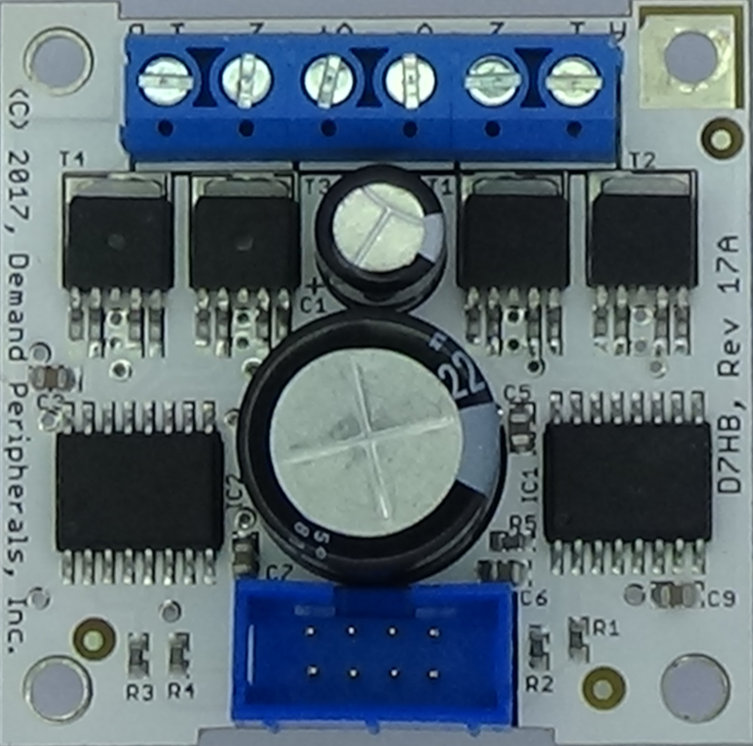



 Demand Peripherals
Robotics and Automation Made Easy
Demand Peripherals
Robotics and Automation Made EasyThe STEPU peripheral controls the step rate, direction, and target step count of a unipolar stepper motor. You can incrementally add counts to the target step count.

Hardware:
The unipolar stepper motor controller controls the on/off state and direction of four open-drain drivers connected to the coils of a unipolar stepper motor. The STEPU peripheral is most often paired with DRV4, the quad open-drain driver card. More information about the DRV4 card can be found here: cards/drv4.html.
Resources:
Resources for the unipolar stepper motor controller let you control direction, step rate, and select either full or half steps.
config : controller configuration.
Stepper motor configuration include the mode of operation,
the direction, the step rate, and the holding current as a
percentage of full current. The configuration format is:
[mode],[direction],[rate],[hold current %]
Three modes of operation are available: off, full-step, and
half-step. The mode is specified as one of the words 'off',
'full', or 'half'. The first letter of each word can also be
used. The off mode removes all power to the drivers. The
power on default mode is off.
The direction is given as 'forward' for a step sequence of ABCD and 'reverse' for a sequence of DCBA. The single letters 'f' and 'r' can also be used. The default is forward.
The motor step rate is given in Hertz. The driver tries to use a step-rate as close as possible to the one specified. For example, a requested step-rate of 511 Hertz might result in an actual step rate of 500 Hertz. The step rate has 8 bits of accuracy, and a range from 4 Hertz to 1 MHz.
The holding current is given as a percentage of full current and is in the range 0 to 99 percent.
Sample configuration commands include the following:
pcset stepu config off forward 400 10
pcset stepu config half reverse 125 25
pcset stepu config f f 200 99
count : target step count.
The count resource specifies the number counts. Is is entered
as a unsigned decimal number in the range of 0 to 4095. This
is a read/write resource. Setting this to zero stops the motor
but leaves the coils energized. This value is decremented by one
for each step (or half step) taken. The motor stops when the
count reaches zero. A read of count show how many steps remain
to be taken but be aware that latency in reading the value from
the board means that the actual steps remaining are probably
fewer that what is reported.
addcount : synchronously add counts to target.
The addcount resource is an unsigned decimal number in the range
of 0 to 4095 that is added to the target count. The addition is
done in the FPGA so that the addition is synchronous to the
steps. Addcount is needed for accurate movement when the target
number of steps is larger than 4095. For example, to accurately
step out 6000 steps, you would write 4000 to count, and then some
time later write 2000 to addcount. This is a write-only resource.
Examples:
Step in the forward direction for 200 full steps at a step rate of 40 steps per second and use a holding current of 10 percent of full power.
pcset stepu config full forward 40 10
pcset stepu count 200
Note that the PWMOUT4 peripheral has four PWM outputs with 12 bits of resolution. You can use the PWMOUT4 peripheral for high resolution (if very slow) micro-stepping of a unipolar stepper motor.